 W
WPishdadian dynasty is a mythological Iranian dynasty. The dynasty is mentioned in the Shahnameh, Avesta and Persian mythology, according to which they were the first rulers of Iran (Persia). Keyumars was the founder and the first shah (king) of the dynasty. In the Avesta he is the mythological first human being in the world. The word pishdad (پیشداد) means the first person to bring the law in Persian language.
 W
WThe Principality of Chaghaniyan, known in Arabic sources as al-Saghaniyan, was a local Iranian dynasty, which ruled the Chaghaniyan region from the early 7th-century to the late 8th-century. The rulers of the region were known by their titles of “Chaghan Khudah”.
 W
WThe Principality of Farghana, was a local Iranian dynasty of Sogdian origin, which ruled the Farghana region from an unknown date to 819. The rulers of the region were known by their titles of “ikhshid” and “dehqan”. The capital of the principality was Akhsikath.
 W
WThe Principality of Khuttal,, was a local Iranian dynasty, which ruled the Khuttal region from the early 7th century to 750. The rulers of the region were known by their titles of “Khuttalan Shah”, “Khuttalan Khudah”, and “Shir-i Khutallan”. The capital and residence of the rulers was in Hulbuk, close to the city of Kulob.
 W
WThe Principality of Ushrusana was a local Iranian dynasty of Sogdian origin, which ruled the Ushrusana region from an unknown date to 892. The rulers of the principality were known by their title of Afshin.
 W
WThe Qarinvand dynasty, or simply the Karenids, was an Iranian dynasty that ruled in parts of Tabaristan (Mazandaran) in what is now northern Iran from the 550s until the 11th-century. They considered themselves as the inheritors of the Dabuyid dynasty, and were known by their titles of Gilgilan and Ispahbadh. They were descended from Sukhra, a Parthian nobleman from the House of Karen, who was the de facto ruler of the Sasanian Empire from 484 to 493.
 W
WWazamar was the ruler of the Khwarazm region of Central Asia in the late 3rd-century. He was succeeded by Afrig in c. 305, who founded the Afrighid dynasty.
 W
WArdakhshir II was king of Persis in the 1st century BC, a vassal state of the Parthian Empire. An inscription written in Middle Persian on a silver cup bears his name. He was succeeded by Wahsir.
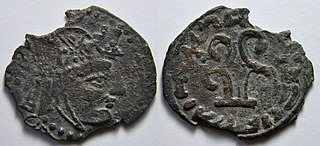 W
WAzkajwar II was the ruler of the Afrighid dynasty of Khwarezm from an unknown date to 712. He was the son and successor of Sabri. Azkajwar II is agreed by most scholars to be the same person as king Jigan or Chigan. In most medieval sources, he is simply called Khwarazmshah.
 W
WAzkajwar-Abdallah was the Afrighid king of Khwarazm from the late 8th-century till the early 9th-century. The precise date of his regnal period is uncertain. He ascended as king after 762, but not later than 783 or 787. He was the grandson of his predecessor Sawashfan. Azkajwar-Abdallah is notable for converting to Islam, taking the Muslim name of Abdallah. He was also the last Afrighid king to have coins minted in pre-Islamic style. The latest discovered coin of Azkajwar-Abdallah cites his overlord the Tahirid dynast Tahir ibn Husayn, who governed Khurasan on behalf of the Abbasid Caliphate in 821–822. Azkajwar-Abdallah was succeeded by Mansur.
 W
WBaydad, was a dynast (frataraka) of Persis from 164 to 146 BC.
 W
WBiwarsar I was the Afrighid ruler of Khwarazm in the third quarter of the 4th-century. He was the predecessor of Baghra, and was succeeded by Kawi.
 W
WThe Bukhar Khudahs or Bukhar Khudats were a local Sogdian dynasty, which ruled the city of Bukhara from an unknown date to the reign of the Samanid ruler Isma'il ibn Ahmad, who incorporated Bukhara into the Samanid state.
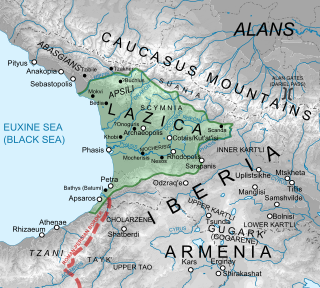 W
WDamnazes was a 6th-century king of Lazica, a contemporary of the Sassanid king of Iran Kavadh I. Damnazes, like other kings of Late Antique Lazica, are mentioned by the contemporary chronicles in the context of the rivalry between the Eastern Roman (Byzantine) Empire and Sassanid Iran in the Caucasus.
 W
WDarayan II was king of Persis in the 1st century BC, a vassal state of the Parthian Empire. He was succeeded by his son Ardakhshir II.
 W
WGondophares I was the founder of the Indo-Parthian Kingdom and its most prominent king, ruling from 19 to 46. A member of the House of Suren, he belonged to a line of local princes who had governed the Parthian province of Drangiana since its disruption by the Indo-Scythians in c. 129 BC. During his reign, his kingdom became independent from Parthian authority and was transformed into an empire, which encompassed Drangiana, Arachosia, and Gandhara. He is generally known from the dubious Acts of Thomas, the Takht-i-Bahi inscription, and coin-mints in silver and copper.
 W
WKai Kobad is a mythological figure of Iranian folklore and oral tradition. The 'Kai' stock epithet identifies Kobad as a Kayanian, a mythological dynasty that in tradition Kai Kobad was also the founder of.
The Kayanians are a semi-mythological dynasty of Persian tradition and folklore which supposedly ruled after the Pishdadians. Considered collectively, the Kayanian kings are the heroes of the Avesta, the sacred texts of Zoroastrianism, and of the Shahnameh, Iran's national epic.
 W
WThe Kings of Persis, also known as the Darayanids, were a series of Persian kings, who ruled the region of Persis in southwestern Iran, from the 2nd century BCE to 224 CE. They ruled as sub-kings of the Parthian Empire, until they toppled them and established the Sasanian Empire. They effectively formed some Persian dynastic continuity between the Achaemenid Empire and the Sasanian Empire.
 W
WMardavij, was a Gilaki prince, who established the Ziyarid dynasty, ruling from 930 to 935.
 W
WThe Masmughans of Damavand were a local dynasty, which ruled Damavand and its surrounding areas from ca. 651 to 760. The founder of the dynasty was a Karenid named Mardanshah of Damavand.
 W
WMazyar, was an Iranian prince from the Qarinvand dynasty, who was the ruler (ispahbadh) of the mountainous region of Tabaristan from 825/6 to 839. For his resistance to the Abbasid Caliphate, Mazyar is considered one of the national heroes of Iran by twentieth-century Iranian nationalist historiography. His name means "protected by the yazata of the moon".
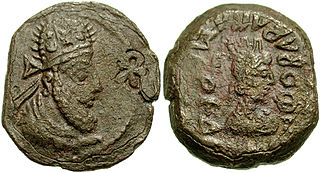 W
WMeredates was a Parthian prince who ruled the state of Characene, a vassal of the Parthian Empire and important trading port, which he ruled from c. 131 to 150/151.
 W
WPapag, was an Iranian prince, who ruled the Istakhr, the capital of Pars, from 205/6 till his death sometime between 207–10. He was the father of Ardashir I, the founder of the Sasanian Empire. He was succeeded by his eldest son Shapur.
 W
WPacores or Pakores was a king who ruled the remnants of the Indo-Parthian Kingdom in Arachosia from 100–130 AD following Ubouzanes. He was an Indo-Parthian king. He is well-known from coins minted in Seistan and Kandahar, mostly silver drachms and tetradrachms. The time of his reign can be determined as many of his coins over strike those of Vima Takto.
 W
WPakor I was king of Persis in the first half of the 1st century CE, a vassal state of the Parthian Empire. He is known to have adopted on his coins the same hairstyle used on the coins of the Parthian king Phraates III.
 W
WSawashfan was the ruler of the Afrighid dynasty of Khwarezm during the 8th-century. He was the son and successor of Askajamuk II.
 W
WShapur was an Iranian prince, who was the penultimate King of Persis from 207–210 to 211/2. He was succeeded by his younger brother Ardashir I, who founded the Sasanian Empire.
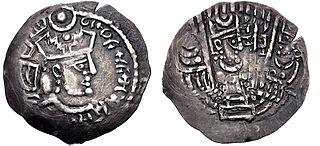 W
WThe Sogdian city-states refers to a number of independent or autonomous city-states in Iranian region of Sogdia in the late antiquity and medieval times. Most of the city-states were ruled by a king or queen, who was called "first among equals". However, the succession of rule was not stable, and the people could influence who would become the new ruler. The period, which experienced its peak in the 7th century, ended with the conquest of Transoxiana by the Islamic Caliphate.
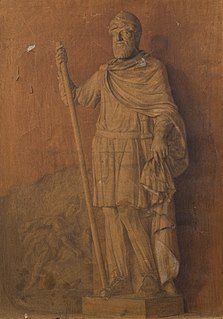 W
WTiridates I was King of Armenia beginning in 53 and the founder of the Arsacid dynasty of Armenia. The dates of his birth and death are unknown. His early reign was marked by a brief interruption towards the end of the year 54 and a much longer one from 58 to 63. In an agreement to resolve the Roman–Parthian conflict in and over Armenia, Tiridates I was crowned king of Armenia by the Roman emperor Nero in 66; in the future, the king of Armenia was to be a Parthian prince, but his appointment required approval from the Romans. Even though this made Armenia a client kingdom, various contemporary Roman sources thought that Nero had de facto ceded Armenia to the Parthian Empire.
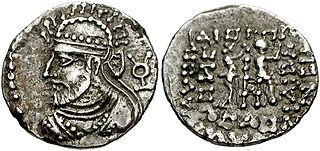 W
WUbouzanes was a ruler of the remnants of the Indo-Parthian Kingdom in Arachosia in the first century CE. He was the son of Orthagnes. He was unknown until the late 20th century when a hoard of coins was found in Jammu. Joe Cribb first analyzed them in 1985, discovering some belonged to a new ruler. Cribb placed him between Orthagnes and Pacores